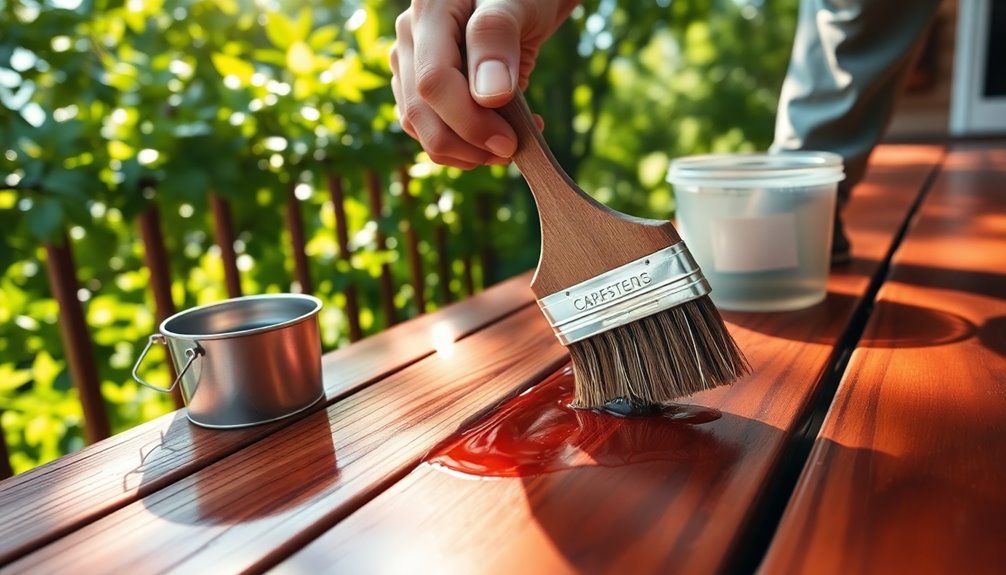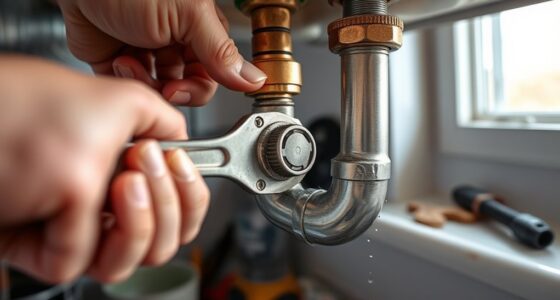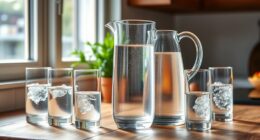To waterproof wood like a pro, start with thorough surface preparation. Clean and dry the wood completely. Choose the right product based on your needs—oil-based sealers penetrate deeply, while water-based options are eco-friendly and easy to apply. Use a brush or roller for even coverage and apply thin coats, allowing time to dry between applications. Regular inspections for peeling or mold are essential. Remember, high-quality solutions often include mold blockers for added protection. Following these steps will guarantee your wooden surfaces remain beautiful and durable. You'll discover even more tips that keep your wood looking its best.
Key Takeaways
- Choose the right waterproofing product: oil-based for deep protection or water-based for easy cleanup and eco-friendliness.
- Prepare the wood surface: ensure it's clean, dry, and free from existing coatings for optimal adhesion.
- Apply thin, even coats: use a brush or roller, allowing adequate drying time between applications for best results.
- Regularly inspect and maintain: check for peeling or discoloration to determine when reapplication is necessary, enhancing longevity.
- Follow application guidelines: keep temperature between 55-90°F and humidity below 85% for effective waterproofing results.
Importance of Waterproofing
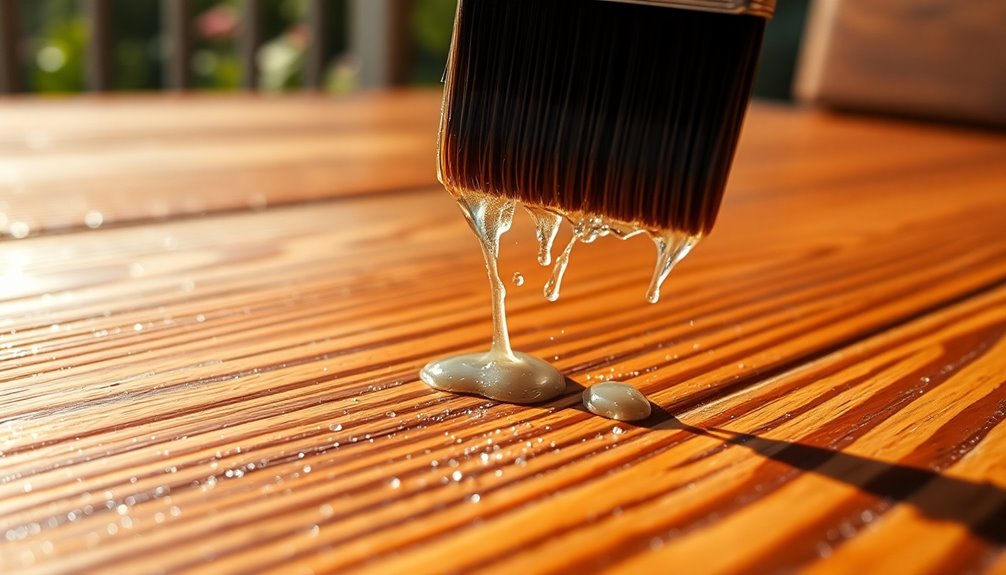
When you consider the longevity of wooden structures, waterproofing becomes essential, as it prevents moisture damage that can lead to decay and structural issues.
By applying a waterproof barrier, you protect wood surfaces from harmful UV rays, humidity, and frost, which can discolor and wear them down over time.
Regular maintenance and reapplication of waterproofing products are vital to monitor any signs of damage, including mold and mildew, ensuring your investment lasts longer.
High-quality waterproofing solutions often include natural oils and mold and mildew blockers that enhance durability while preserving aesthetics.
Types of Waterproofing Products
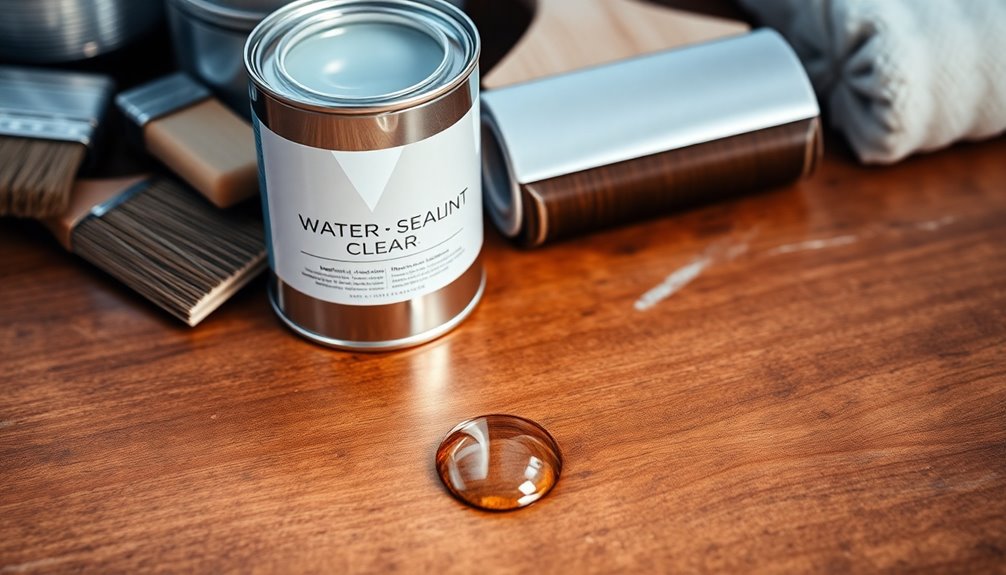
Choosing the right waterproofing product is essential for protecting your wood from moisture damage. You can choose from oil-based sealers that provide deep penetration for long-lasting protection or water-based options that offer easy cleanup and are environmentally friendly.
Clear waterproofers often contain mildewcides to prevent mold growth, while tinted versions give UV protection and enhance your wood's natural beauty. High-quality sealants create a reliable moisture barrier, making them ideal for long-term projects.
If you need robust protection, consider liquid waterproofing membranes, which are excellent for roofs and foundations, sealing out water intrusion effectively.
No matter your choice, investing in effective wood waterproofing products guarantees your surfaces remain in great shape for years to come.
Techniques for Waterproofing Wood
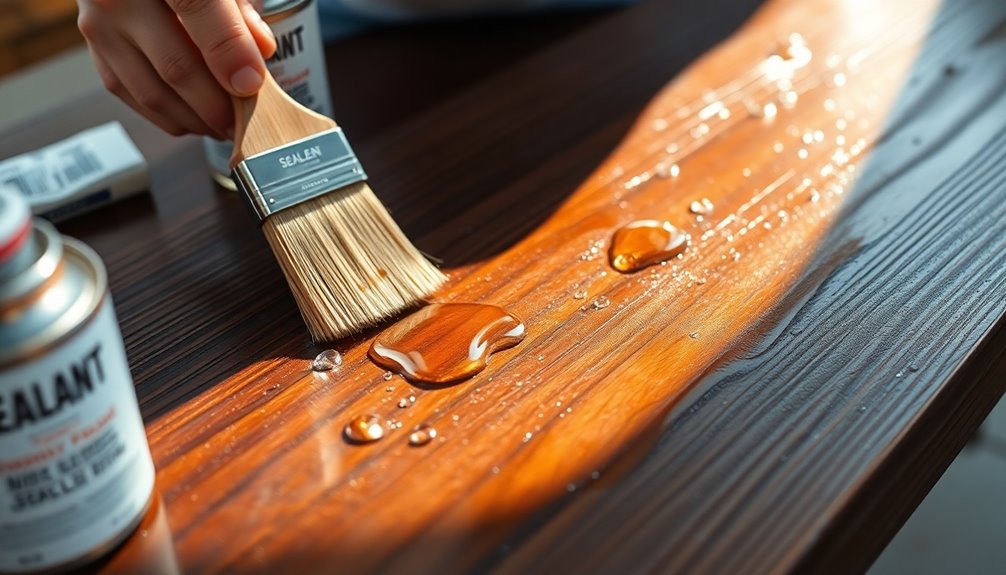
To waterproof wood effectively, you need to start with proper surface preparation.
This means cleaning the wood and ensuring it's dry before applying any products.
Once you're ready, understanding the right application methods will help you achieve the best results.
Surface Preparation Essentials
Effective waterproofing starts with proper surface preparation, as it guarantees the wood is clean, dry, and free from coatings or debris.
Begin by cleaning the wood thoroughly using a general cleaner or pressure washer to eliminate dirt, mold, and previous finishes that could hinder waterproofing.
After cleaning, sand the surface to remove imperfections, enhancing adhesion for the sealant.
Aim for a moisture content of 12% or less; allow the wood to dry completely for 24-48 hours post-cleaning and sanding to prevent moisture from being trapped under the waterproofing layer.
Finally, test a small area before full application to verify compatibility and effectiveness, allowing you to make any necessary adjustments based on the wood type and environmental conditions.
Application Methods Overview
Application methods play an essential role in waterproofing wood effectively.
To start, clean the surface thoroughly, using a pressure washer, and let it dry for up to 48 hours for proper adhesion. Once the surface is completely dry, inspect it for any cracks or damage that may need addressing before proceeding with repairs. Applying a suitable adhesive or patching compound can enhance the durability of the surface, ensuring long-lasting results. Additionally, it’s essential to consider the best air mattress repair methods, as they can help you maintain the quality of your air mattress and extend its lifespan effectively.
Choose your application method—brush or roller works well for both stains and sealers.
When you apply the sealant, use thin coats to guarantee even coverage; allow 1-2 hours for water-based products and 2-4 hours for oil-based products to dry in between.
Don't forget to sand the wood surface lightly between coats for better adhesion.
Regular inspections and reapplication are critical to protect your wood furniture from moisture damage, as the frequency of maintenance depends on environmental exposure.
Application Guidelines and Methods
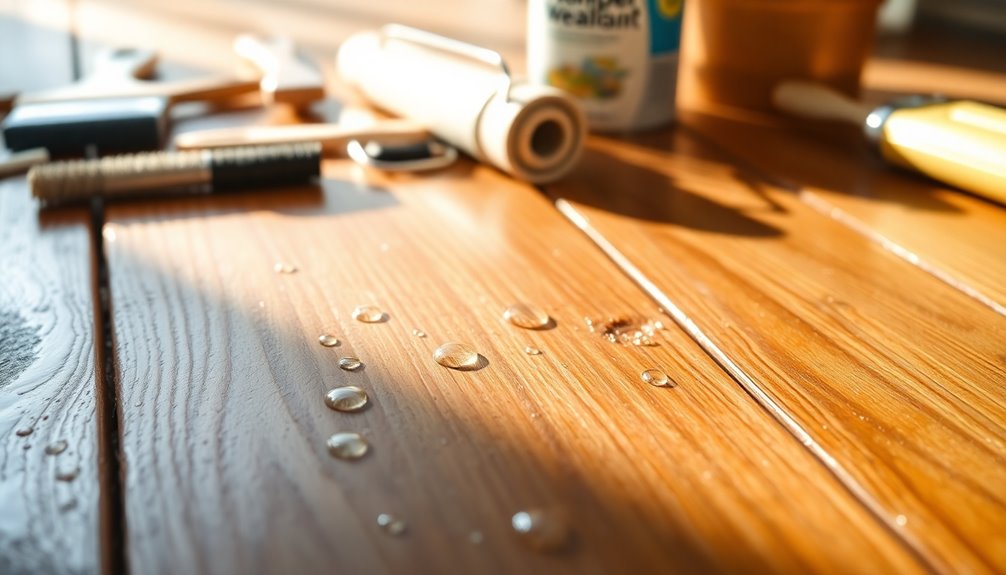
Before you start waterproofing, make certain the wood is dry and clean to guarantee the best adhesion.
You'll also want to follow proper application techniques to achieve ideal results.
Let's go over the essential preparation steps and methods that will make your waterproofing project successful.
Essential Preparation Steps
Proper preparation is key to achieving a successful waterproofing job on wood. Start by ensuring the wood is completely dry; use a pin-type moisture meter to check that the moisture content is 12% or less.
Next, prepare the surface by removing any existing coatings with strippers or sandpaper. Clean the wood thoroughly using a vacuum or mineral spirits to enhance adhesion for the waterproofing product.
When you're ready to apply, make sure the temperature is between 55 to 90°F and humidity is below 85%. If you're using natural oil, mix it well and apply in the grain's direction, allowing it to soak for 15 minutes.
Limit your coats to two and remember to clean your tools with mineral spirits after use.
Proper Application Techniques
Achieving a successful waterproofing job on wood requires careful attention to detail and technique.
Start by ensuring the wood's moisture content is 12% or less. Follow these steps for ideal results:
- Clean the wood surface of dirt and coatings.
- Sand it down to improve adhesion.
- Apply the oil with the grain, allowing the oil to penetrate for 15 minutes.
- Wipe off any excess after the first coat.
- Dry completely before reapplying, sticking to the manufacturer's guidelines.
Cost Considerations and Maintenance
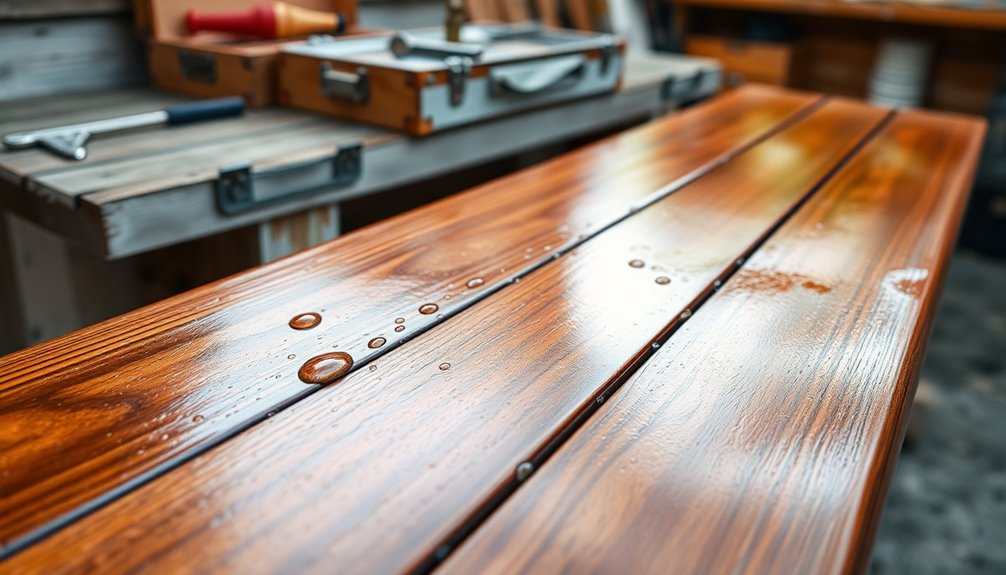
While considering waterproofing wood, it's vital to balance initial costs with long-term maintenance needs.
Natural wood oils and other cost-effective methods may save you money upfront, but they often require frequent reapplication, especially in areas subjected to high environmental exposure.
High-quality sealants, while pricier initially, offer superior durability and UV protection, making them ideal for outdoor furniture and long-term projects.
Regular maintenance is fundamental; inspect for signs of peeling or discoloration, which indicate reapplication is necessary.
Adopting a tailored reapplication schedule based on specific conditions can greatly enhance the lifespan of your wooden surfaces.
Ultimately, investing in high-quality sealants can lead to reduced maintenance efforts and costs over time.
Safety Precautions
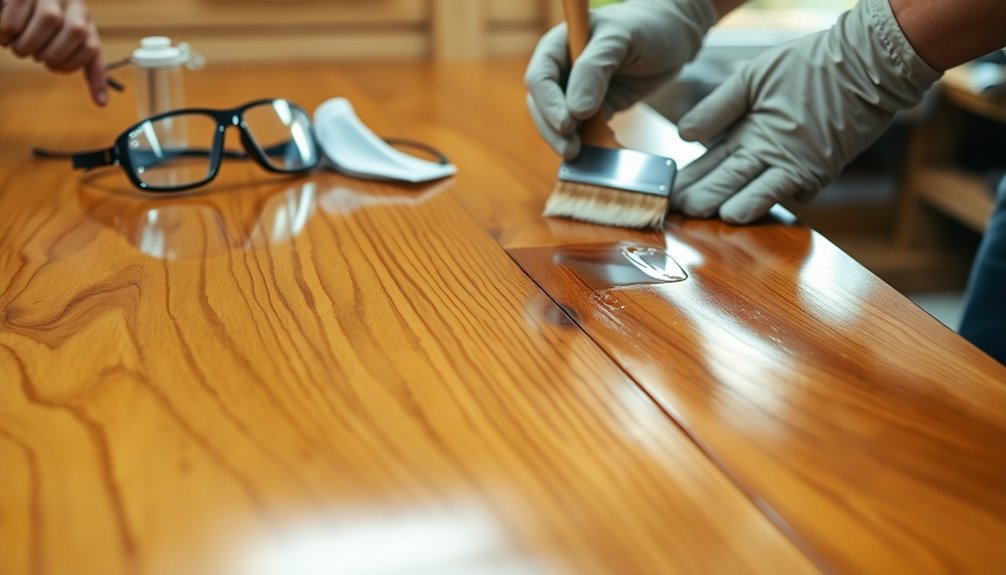
When applying waterproofing agents, it's vital to prioritize your safety to prevent potential hazards.
Here are some essential safety precautions to keep in mind:
- Always wear protective eyewear and gloves to shield against chemicals.
- Guarantee proper ventilation in your workspace to minimize inhaling harmful fumes.
- Follow the manufacturer's safety guidelines and refer to the material safety data sheets (MSDS).
- Keep flammable materials away from your work area, as many waterproofing products contain ignitable solvents.
- Store waterproofing supplies in a cool, dry place, out of reach of children and pets to avoid accidental exposure.
Expert Recommendations
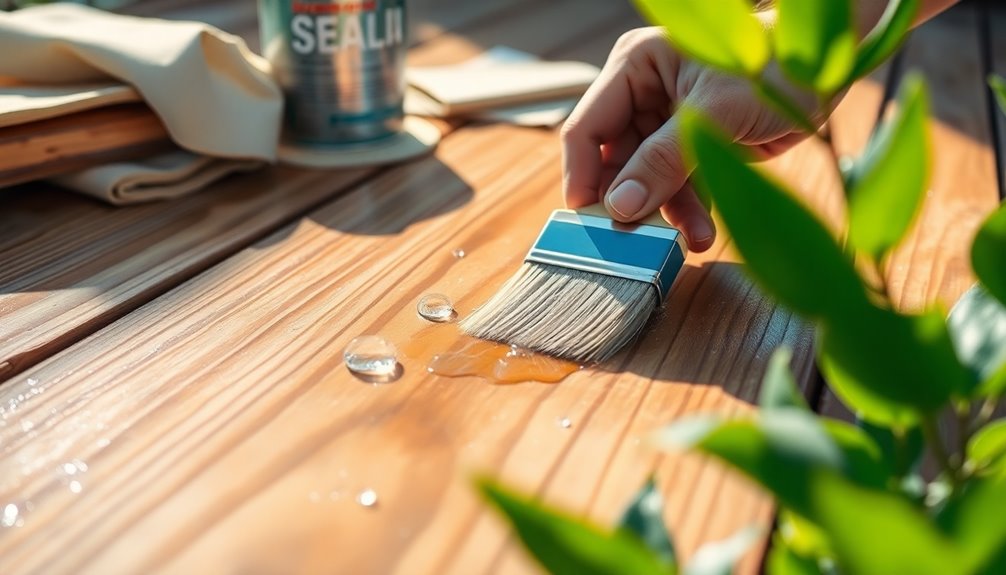
To achieve ideal waterproofing results, experts recommend using a combination of high-quality sealants and proper application techniques. Polyurethane sealants are favored for their long-lasting protection against moisture and resistance to UV damage. For outdoor projects, consider applying natural oils like tung or linseed oil, but remember they need reapplication every 6 to 12 months. Confirm the wood is completely dry, ideally with a moisture content of 12% or less, to avoid trapping moisture. Regular maintenance is essential for extending the lifespan of your wood surfaces. Additionally, using high-quality protein sources in sealants can help maintain their effectiveness over time.
| Method | Benefits |
|---|---|
| Polyurethane Sealants | Superior UV and moisture protection |
| Epoxy + Varnish | Durable barrier against elements |
| Natural Oils | Enhances beauty, water-resistant |
| Regular Inspections | Prevents costly repairs |
Frequently Asked Questions
What Is the Best Thing to Waterproof Wood With?
To waterproof wood effectively, you've got several great options.
Oil-based sealers penetrate deep, creating a strong barrier while maintaining the wood's look.
Polyurethane products are durable and resist yellowing, perfect for high-traffic areas.
If you want a tough, UV-resistant finish, high-quality varnish is ideal.
For outdoor projects, consider combination stain and sealer products that enhance color while providing waterproofing.
Just remember, natural oils need more frequent reapplication for protection.
How Do You Make Wood 100% Waterproof?
To make wood 100% waterproof, you'll need to focus on a few key steps.
Start by using penetrating epoxy for a solid base.
Then, apply high-quality sealants like polyurethane in multiple coats.
Always guarantee the wood's dry—aim for 12% moisture content or less.
Test a small area first to see how well the product works.
Finally, remember to maintain and reapply every 6 to 12 months for lasting protection.
What Do You Put Over Wood to Protect It?
To protect wood effectively, you can apply wood sealers, varnish, or polyurethane.
Sealers create a moisture-repelling barrier, while varnish offers UV protection, making it great for outdoor surfaces.
Polyurethane is durable and easy to apply, but you'll want multiple coats for the best results.
If you prefer a natural look, consider using oil like linseed or tung oil.
Combining stain and sealer can also enhance color while adding waterproofing protection.
What Is the Best Way to Protect Wood From the Weather?
To protect wood from the weather, you should apply a high-quality sealant, like polyurethane, which creates a tough waterproof barrier.
If you want to maintain the wood's natural look, consider using natural oils such as tung or linseed oil, though they'll need reapplication every few months.
A stain and sealer combo can also enhance color and provide moisture protection.
Regularly check for damage and reapply treatments to keep your wood in top shape.
Conclusion
To summarize, waterproofing your wood isn't just about aesthetics; it's essential for longevity. Did you know that untreated wood can absorb up to 30% of its weight in water? That's a lot of potential damage! By choosing the right products and techniques, you're not just protecting your surfaces—you're investing in their future. So, roll up your sleeves, follow the guidelines, and watch your wood thrive against the elements like a pro!
